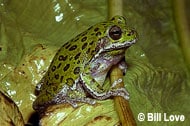Description:
Barking treefrogs are a large, colorful species, with a predominantly green dorsal coloration that is typically broken up by scattered dark spots. At night or during periods of stress, the color will change from green to a deep purple or brown. Males can be differentiated from females by the presence of a green or yellow throat. Barking treefrogs can be kept quite simply in captivity, when provided with a few basic requirements. A variety of substrates will suit the needs of these frogs, including everything from simple paper toweling to more natural substrates, such as peat or green moss, coco coir, or a mixture of coco coir and orchid bark. It is important to have a drainage layer at the bottom of the enclosure, which can be made using either large grade pea gravel or LECA (expanded clay pellets), and then covering this with fiberglass window screening to prevent the finer substrate from filling the gaps in the drainage layer. Suitable plants include philodendron, pothos, Aglaonema, dieffenbachia, and other large-leaved sturdy plants. It is also important to provide a large, clean water dish to allow these animals to soak regularly. Crickets make a good staple food item. Supplement these with small mealworms and small silk moth larvae. Barking treefrogs have a voracious appetite and can become obese if overfed. Gut loading crickets with a large variety of vegetables and commercial cricket food is a good way to provide nutritious food items. Dusting the food items with a vitamin/mineral supplement is also a good idea with this species, especially for younger animals still undergoing periods of rapid growth. This will help to ensure proper bone development.
Habitat:
Barking treefrogs utilize both arboreal and terrestrial environments within the regions they occur. During dry conditions, they will burrow into the ground or hide under surface cover to avoid desiccation.
Range:
Barking treefrogs are found, for the most part, in the southeastern United States as far west as extreme eastern Louisiana and as far north as southeastern Virginia.
Scientific Name: Hyla gratiosa
Species Group: frog
Family: Hylidae
Size: Adults measure from 2 to 2¾ inches in total length, making them one of the larger treefrogs found naturally in the United States.
Level: beginner
Weight: N/A
Dangerous: No



